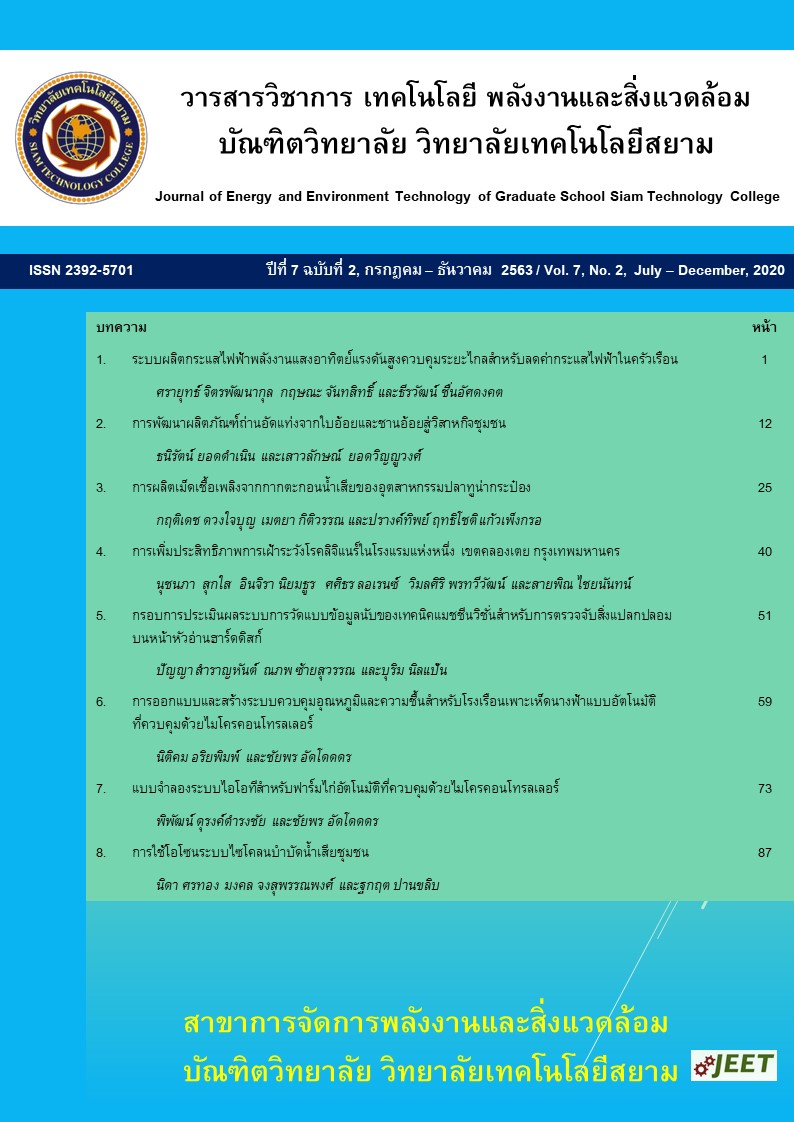Increasing Efficiency of Legionnaires’ Disease Surveillance System in a Selected Hotel of Khlongtoey Bangkok
Main Article Content
Abstract
Legionnaires’ Disease is a pneumonia caused by inhaling the Legionella bacteria which spreads through water droplets into the body. It can be found in all regions of the world and is also found in Thailand, which is a tropical country which has suitable temperature and humidity for the growth of Legionella. The Thai Ministry of Public Health has monitored outbreaks among foreign tourists who have stayed in hotels in Bangkok and throughout the country. Due to the infection of tourists by Legionella affect image of Thailand tourism. Legionnaires' Disease has a high mortality rate. In Thailand, there is a history of Legionnaires' Disease outbreaks in late 2006. Therefore, it is important to prevent the contamination of Legionella in the hotels in Thailand.
This research is a descriptive study aimed at enhancing the surveillance of Legionella in hotels where Legionella was reported. The water samples were collected from the hotel's water supply sources such as water from cooling tower, hot and cold water faucets in the guest room, from the shower, hot water tank, cold water tank on the roof top and underground, which could be home of Legionella and could spread the germs to the hotel guests or residents. Legionella could be detected in all water sources where water samples were collected, except for underground cold water tanks. SWOT analysis determines the cause of contamination, enabling the creation of contamination surveillance measures. Compare the findings of Legionella before and after the use of surveillance measures. It is found that after the surveillance, which the water samples were collected every month. After the first month, Legionella was only found in water from cooling tower, hot and cold faucets from guest rooms. Subsequently, Legionella was not detected from all water sources over the course of 12 months. Therefore, in order to ensure effective monitoring of Legionella contamination, it is necessary to strictly follow the plan of Legionnaires’ Disease surveillance.
Article Details
เนื้อหาและข่อมูลในบทความที่ลงตีพิมพ์ในวารสารวิชาการ เทคโนโลยี พลังงาน และสิ่งแวดล้อม บัณฑิตวิทยาลัย วิทยาลัยเทคโนโลยีสยาม ถือเป็นข้อคิดเห็นและความรับผิดชอบของผู้เขียนบทความโดยตรง ซึ่งกองบรรณาธิการวารสารไม่จำเป็นต้องเห็นด้วย หรือว่าร่วมรับผิดชอบใด ๆ
บทความ ข้อมูล เนื้อหา รูปภาพ ฯลฯ ที่ได้รับการตีพิมพ์ในวารสารวิชาการ เทคโนโลยี พลังงาน และสิ่งแวดล้อม บัณฑิตวิทยาลัย วิทยาลัยเทคโนโลยีสยาม ถือเป็นลิขสิทธิ์ของวารสารวิชาการ เทคโนโลยี พลังงาน และสิ่งแวดล้อม บัณฑิตวิทยาลัย วิทยาลัยเทคโนโลยีสยาม หากบุคคล หรือหน่วยงานใดต้องการนำทั้งหมด หรือส่วนหนึ่งส่วนใดไปเผยแพร่ต่อ หรือเพื่อกระทำการใด ๆ จะต้องได้รับอนุญาต เป็นลายลักษณ์อักษรจากวารสารวิชาการ เทคโนโลยี พลังงาน และสิ่งแวดล้อม บัณฑิตวิทยาลัย วิทยาลัยเทคโนโลยีสยาม เท่านั้น
References
นิจศิริ เรืองรังษี และ ชนิดา พลานุเวช. (2554). การเฝ้าระวังสุขภาวะและความเสี่ยงจาการติดเชื้อโรคในสปา, วิทยาลัยวิทยาศาสตร์สาธารณสุข จุฬาลงกรณ์มหาวิทยาลัย.
ปานทิพย์ ผลความดี. (2561). การเพิ่มประสิทธิภาพการเฝ้าระวังโรคลีเจียนแนร์ในโรงแรมพื้นที่เขตวัฒนาโดยใช้เครือข่าย. สถาบันพัฒนาข้าราชการกรุงเทพมหานคร
พิพัฒน์ ลักษมีจรัลกุล และคณะ. (2557). ความชุกของการปนเปื้อนเชื้อลีจิโอเนลล่า นิวโมฟิล่าและลักษณะการดูแลบำรุงรักษาคูลลิ่งทาวเวอร์ที่ติดตั้งในสถานที่บางแห่ง กรุงเทพมหานคร. สงขลานครินทร์เวชสาร. 32(1), 1-10.
สมชัย บวรกิตติ. 2552. โรคทางละอองน้ำในอากาศ. วารสารวิจัยระบบสาธารณสุข, 3(4), 489-494.
สมภพ ญาณพิสิฐกุล และนัยนา ศรีชัย. (2556). ความชุกของเชื้อลีจีโอเนลล่า (Legionella sp.) ในหอผึ่งเย็นของโรงแรมในตำบลป่าตอง จังหวัดภูเก็ต, การประชุมหาดใหญ่วิชาการ ครั้งที่ 4 “การวิจัยเพื่อพัฒนาสังคมไทย” วันที่ 10 พฤษภาคม 2556, มหาวิทยาลัยหาดใหญ่.
สำนักอนามัยสิ่งแวดล้อม กรมอนามัย กระทรวงสาธารณสุข. (2550). การควบคุมเฝ้าระวังปัญหาการแพร่ระบาด โรคลีเจียนแนร์. พิมพ์ครั้งที่ ๒ สำนักงานกิจการโรงพิมพ์ องค์การสงเคราะห์ทหารผ่านศึก. กรุงเทพ.


